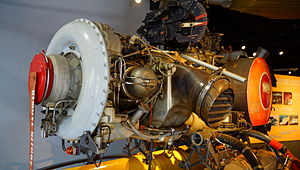Boeing T50
Appearance
(Redirected from Boeing 502)
| T50 | |
|---|---|

| |
| Type | Turboshaft |
| National origin | United States |
| Manufacturer | Boeing |
| Major applications | QH-50 DASH |
| Developed into | Boeing T60 |
The Boeing T50 (company designation Model 502) was a small turboshaft engine produced by Boeing. It was the first turboshaft engine to ever power a helicopter: a modified Kaman K-225 in 1951.[1] Based on Boeing's earlier Model 500 gas generator, the T50's main application was in the QH-50 DASH helicopter drone of the 1950s. An up-rated version designated Model 550 was developed to power the QH-50D and was given the military designation T50-BO-12.
Two T50 were tested on a HTK-1 (Kaman HH-43 Huskie) in the 1950s, which was the first test of twin turbine engine on a helicopter.[2]
Variants
[edit]- T50-BO-1
- T50-BO-2
- T50-BO-4
- 270 hp (201.34 kW) at 6,000 output rpm, military rating turboprop.[3]
- T50-BO-6
- T50-BO-8
- 300 hp (223.71 kW) at 5,950 output rpm, revised reduction gear ratio, fuelsystem and other changes.[3]
- T50-BO-8A
- T50-BO-10
- 330 hp (246.08 kW) at 6,000 output rpm[3]
- T50-BO-12
- 502-1-1
- Auxiliary power unit
- 502-2E
- Turboprop, 175 hp (130.50 kW) at 2,900 output rpm max. continuous at sea level.[4]
- 502-7B
- Compressed air generator.[4]
- 502-8A
- Turboshaft.[4]
- 502-8B
- Turboprop, 210 hp (156.60 kW) at 37,500 compressor rpm for take-off.[4]
- 502-10B
- Turboprop, 270 hp (201.34 kW) at 37,500 compressor rpm for take-off.[4]
- 502-10C
- Turboshaft power unit / gas producer
- 502-10F
- [5]
- 502-10V
- (T50-BO-4)
- 502-10VB
- 325 hp (242.35 kW) at 3,000 output rpm, variant of -10V / T50-B0-4 with revised reduction gear ratio.[3]
- 502-10VC
- (T50-BO-8)
- 502-11
- Compressed air generator.[4]
- 502-11B
- 502-12B
- 502-W
- 502-14
- (T50-BO-10)
- 550-1
- (T50-BO-12)
Applications
[edit]- T50 (Model 502)
- GT502
Specifications (T50-BO-10 / 502-14)
[edit]
Data from Jane's All the World's Aircraft 1962-63.[3]
General characteristics
- Type: Turboshaft
- Length: 37.2 in (945 mm)
- Diameter: 22.5 in (572 mm)
- Dry weight: 215 lb (98 kg)
Components
- Compressor: Single-stage centrifugal flow
- Combustors: 2 can combustors
- Turbine: 1 axial gas generator power turbine stage and 1 axial free-power turbine stage
- Fuel type: Aviation kerosene
- Oil system: pressure spray/splash, oil specification: MIL-L-7808
Performance
- Maximum power output: 330 hp (246.08 kW) military rating at 6,000 output shaft rpm
- Overall pressure ratio: 4.35:1
- Air mass flow: (4.1 lb (2 kg))/s
- Turbine inlet temperature: Jet pipe Temperature: 1,140 °F (616 °C)
- Specific fuel consumption: 0.87 lb/(hp h) (0.532 kg/(kW h))
- Power-to-weight ratio: 1.535 hp/lb (2.523 kW/kg)
See also
[edit]Related development
Related lists
References
[edit]Notes
[edit]- ^ Schenderlein, John; Clayton, Tyler (2015-12-17). "Comparison of Helicopters Turboshaft Engines" (PDF). American Institute of Aeronautics and Astronautics: 2. Retrieved 2023-06-07.
- ^ "Kaman Helicopters". www.airvectors.net. Retrieved 2024-05-16.
- ^ a b c d e Taylor, John W.R. FRHistS. ARAeS (1962). Jane's All the World's Aircraft 1962-63. London: Sampson, Low, Marston & Co Ltd.
- ^ a b c d e f Bridgman, Leonard (1955). Jane's all the World's Aircraft 1955-56. London: Jane's all the World's Aircraft Publishing Co. Ltd.
- ^ Bridgman, Leonard, ed. (1959). Jane's all the World's Aircraft 1959–60. London: Sampson Low, Marston & Co. Ltd. pp. 521–522.
Bibliography
[edit]- Taylor, John W.R. FRHistS. ARAeS (1962). Jane's All the World's Aircraft 1962-63. London: Sampson, Low, Marston & Co Ltd.
- Gunston, Bill (2006). World Encyclopedia of Aero Engines, 5th Edition. Phoenix Mill, Gloucestershire, England, UK: Sutton Publishing Limited. p. 79. ISBN 0-7509-4479-X.
- Leyes II, Richard A.; William A. Fleming (1999). The History of North American Small Gas Turbine Aircraft Engines. Washington, DC: Smithsonian Institution. ISBN 1-56347-332-1.
External links
[edit]Wikimedia Commons has media related to Boeing T50.
- Boeing Model 502 Gas Turbine Engine
- "Jet Sheds Weigh" , September 1947, Popular Science article at bottom of page on earlier Model 500
